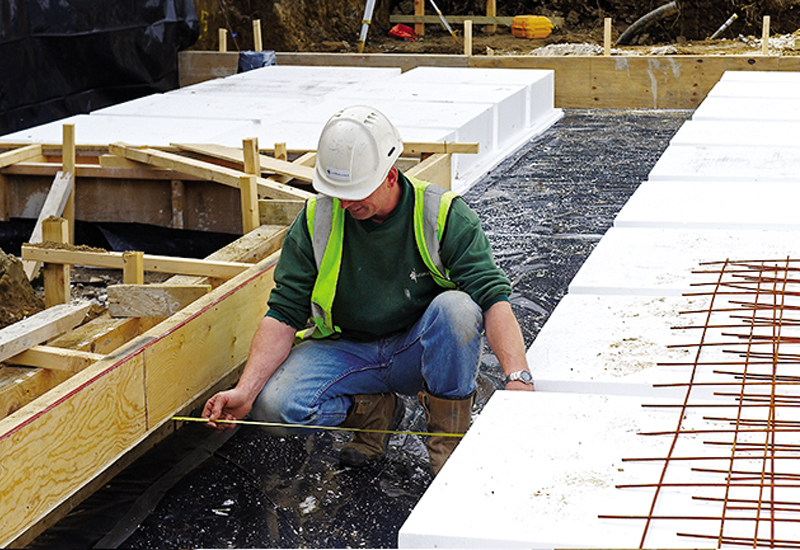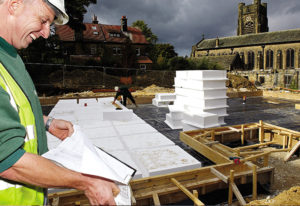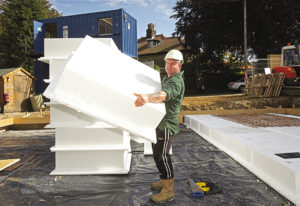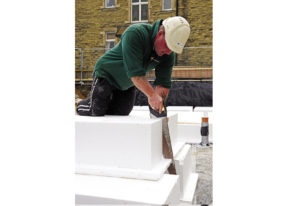
Adrian Crow, Technical Manager, Insulslab, discusses the importance of site investigation and why this ultimately determines foundation specification and design in new housing developments.
The challenges faced on brownfield sites often include remediation of the ground, access to the site and actual ground conditions. For example, sites formerly used for industrial purposes will typically require gas venting in order to achieve planning permission and even where this is not necessary, it is not uncommon to have to accommodate sloped areas to maximise the land available for construction.
 When considering the use of brownfield land for housing developments; foundation design should only be undertaken once a comprehensive site investigation is carried out and conclusive results achieved. The report from such an investigation should then specify the ground remediation works to be completed. Best practice is for a representative sample to be taken throughout to site. From here, the most suitable foundation construction will be identified. Whilst piled or traditional rafts are most commonly used for brownfield construction, alternatives do exist which offer a robust and cost effective solution for housebuilding under these circumstances.
When considering the use of brownfield land for housing developments; foundation design should only be undertaken once a comprehensive site investigation is carried out and conclusive results achieved. The report from such an investigation should then specify the ground remediation works to be completed. Best practice is for a representative sample to be taken throughout to site. From here, the most suitable foundation construction will be identified. Whilst piled or traditional rafts are most commonly used for brownfield construction, alternatives do exist which offer a robust and cost effective solution for housebuilding under these circumstances.
One example of an alternative incorporates steel fibre reinforced concrete (SFRC) in place of standard steel reinforcement, and integrates high levels of insulation into the foundation construction. In doing so, this approach offers a number of performance advantages, particularly where integrity under challenging conditions is concerned.
Understanding parameters
When assessing the foundation options available, operating under the ‘worst case’ parameters will offer a better level of protection than hoping for ‘best case’ scenario, with regards to the ground remediation and subsequent performance.
Although this is not traditionally used for raft foundations, consulting engineers, GHW, performed a Finite Element Analysis (FEA) using an integrated raft system and an illustrative example of poor ground conditions. Having run the model using four conditions and ‘full live loads’ at all times:
- Steel fibred reinforced concrete – quality installation
- Steel fibre reinforced concrete – poor quality installation
- Ground stability – firm
- Ground stability – soft
GHW identified that the SFRC foundation system used in a raft/waffle plane would maintain its integrity and continue to distribute the building load evenly in all conditions. Note that all SFRC rafts are designed to span a 3.0m simply supported loss of support or a 1.5m cantilever anywhere under the building.
Cap On piles
Insulslab was adopted by Lincolnshire based HPC Homes for a housing development in Ramsey St Mary’s, Cambridgeshire. Used as a cap on piles at the former agricultural site, Insulslab facilitated efficient site progression by removing the need for a ‘dig off’, which would have been required with a traditional ring beam detail.
The high peat content and poor ground bearing capacity at the rural site dictated that piled foundations were necessary to achieve stability for construction. Evaluating traditional foundation techniques against modern methods of construction, HPC Homes concluded that Insulslab provided an ideal solution for improving efficiency, in spite of the need to install piled foundations.
 Simon Atkinson, Contracts Manager, HPC Homes, comments: “By combining Insulslab with a traditional piled foundation technique, we were able to realise tangible time savings on-site, which is critical with any development.”
Simon Atkinson, Contracts Manager, HPC Homes, comments: “By combining Insulslab with a traditional piled foundation technique, we were able to realise tangible time savings on-site, which is critical with any development.”
In contrast with standard ring beam details, the system required only minimal ground preparation without the need to excavate trenches, install cage reinforcement and sub structure brickwork. By reducing the labour time in this way, it contributed to an overall project cost saving and on-site efficiency gains.
Making rafts plain sailing
Bovis Homes adopted Insulslab as the preferred foundation system when it was contracted to build 222 two, three and four bedroom homes in Pebble Beach, Devon. The new development is based on the Jurassic Coast, just a short stroll from the mile long pebble beach from which the development takes its name.
The geology of the site, a former caravan park, consisted of salt marsh deposits overlying Branscombe Mudstone Formation. To remediate the ground in preparation for build, a significant enabling works operation was necessary which involved raising site levels through importing marine dredged sand. Subsequent site investigation and geotechnical analysis confirmed a maximum bearing pressure of 50kN/m2.
Based on the geotechnical profile, Bovis specified that a raft foundation would be required to meet the load bearing pressures of the ground. Ordinarily a more costly foundation technique than trench or beam and block; by working with the Insulslab technical team, Bovis was able to realise the performance benefits of a traditional raft construction – but with additional time and cost savings.
These savings were possible due to the design and installation process of Insulslab. Using interlocking EPS (expanded polystyrene) pods which are laid on the ground according to the specified design, the Insulslab foundation is completed by steel fibre reinforced concrete being poured on top. In doing so, a raft foundation is essentially created which has inherent structural integrity, the ability to evenly spread load and delivers the ground up to floor level.
Douglas Mobbs, Engineering Manager at Bovis Homes noted: “We needed to improve on a traditional raft solution and Insulslab provided a design which exactly addressed our requirements. It worked well with the overall development programme and allowed the smooth placing of orders and efficient supply of materials. The careful planning and effective coordination between parties ensured the foundations were constructed well ahead of the superstructure programme, which ultimately allowed the development to progress at an excellent pace.”








